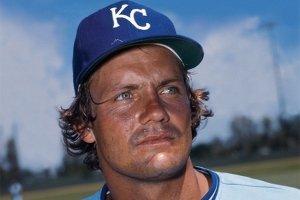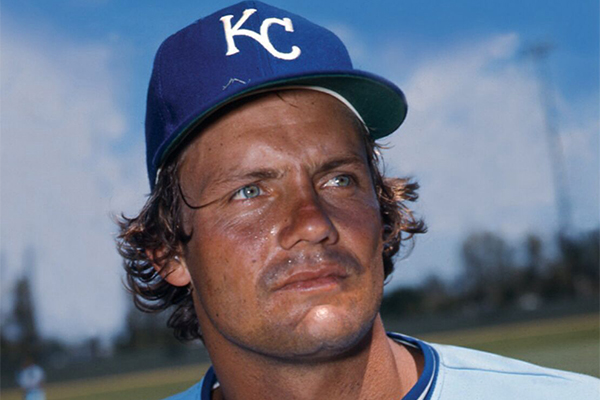August 17, 1980: George Brett raises batting average above .400
 It was serendipity that George Brett even got his fifth plate appearance against the Toronto Blue Jays on Sunday night, August 17, 1980, as the Kansas City Royals closed out a brief homestand. It was the eighth inning. In the seventh, Brett had broken a tie with a double and the Royals, leading the American League West Division by 13 games,1 were now coasting with a 5-3 lead against the moribund Blue Jays.2 But even though Ken Schrom, Toronto’s third pitcher of the night, quickly got two outs and three batters remained before Brett’s spot in the order, the 30,693 fans rocking Royals Stadium had just seen U L Washington drill a single up the middle and Amos Otis and John Wathan both work Schrom for walks to load the bases for Brett.
It was serendipity that George Brett even got his fifth plate appearance against the Toronto Blue Jays on Sunday night, August 17, 1980, as the Kansas City Royals closed out a brief homestand. It was the eighth inning. In the seventh, Brett had broken a tie with a double and the Royals, leading the American League West Division by 13 games,1 were now coasting with a 5-3 lead against the moribund Blue Jays.2 But even though Ken Schrom, Toronto’s third pitcher of the night, quickly got two outs and three batters remained before Brett’s spot in the order, the 30,693 fans rocking Royals Stadium had just seen U L Washington drill a single up the middle and Amos Otis and John Wathan both work Schrom for walks to load the bases for Brett.
The ballpark was rocking because the 27-year-old Brett had entered the game with a .394 batting average, was riding a 28-game hitting streak that dated back to July 18 in Yankee Stadium, was 3-for-3 with a walk, and would get to bat again. As he stepped in his average was .399, on the cusp of reaching the mystical .400 level generally considered unattainable so late in the season. If their guy was going to edge above the mystical mark, the fans wanted to see it done at home, not on the road against the Texas Rangers, where Kansas City would play the next three games.
In his seventh full season as the Royals’ third baseman after a brief appearance at the end of the 1973 season and a permanent call-up in early May of 1974, Brett had missed a handful of games early in the 1980 season and 26 consecutive games from June 10 to July 10 with a collection of heel, ankle, and wrist injuries.3 Except for reaching .364 after the third game of the season, he hadn’t even topped .300 until May 31. When he injured his right ankle in a successful stolen-base attempt at Cleveland on June 10,4 he was hitting .337. Healed and back in the lineup on July 10, he hit at a .515 clip with safeties in seven of eight games until lefty John Tudor of the Red Sox held him hitless in Fenway Park on July 17. Brett got the 28-game streak going the next night in New York, and he and the Royals were still red-hot as they hosted the Torontonians on August 17.5
Toronto manager Bobby Mattick had tabbed his co-ace, 24-year-old Jim Clancy,6 as his starter. Clancy was a creditable 11-8 (3.14 ERA) and coming off a complete-game win at Milwaukee five days earlier. This night, though, he walked his way into trouble after his team went down in order in the first inning against bespectacled left-hander Paul Splittorff (8-8, 4.64), Kansas City manager Jim Frey’s choice to start. Clancy walked Kansas City’s leadoff hitter, Willie Wilson, who stole second base with John Wathan batting. Wathan popped out, but Brett, hitting third, also walked, as did Darrell Porter, the cleanup hitter. Willie Aikens drove in Wilson with a force out to second base before Clancy regrouped to strike out Hal McRae, stranding Brett and Porter and escaping further damage.
Toronto gained a 1-1 tie in the top of the third when Royals second baseman Dave Chalk booted Alfredo Griffin’s groundball and Danny Ainge romped home from third base. Ainge had doubled with one out and moved to third on a single by Ernie Whitt. The Jays managed a 2-1 lead against Splittorff in the fourth on a squeeze bunt by Garth Iorg that scored Otto Velez; he had singled to open the half-inning, then wheeled to third base on Damaso Garcia’s single.
Brett had efficiently singled off Clancy in the third to run his streak to 29 games, and Jamie Quirk tied the game at 2-2 in the Kansas City fourth as he led off with his fifth home run of the season. With the score still tied, Brett willed himself “an infield single in the fifth, beating a demoniacal path to the bag [and] arriving before the throw from first baseman John Mayberry to pitcher Jim Clancy.”7 Brett tried to keep the pressure on with an attempt to steal second base, but Whitt gunned him down for the second out of the half-inning.8
Splittorff rolled on through the sixth and seventh innings without damage. Clancy negotiated the sixth safely, but had to face Brett again in the seventh, this time with two outs but with White and Wathan on the corners via two more of the six bases on balls the big righty issued in the game. With a runner on first, the Jays took their chances, pitching to Brett in a potential game-altering situation. That potential became reality. Brett electrified the crowd with a ringing two-run double to right field that bumped the score to 4-2 and ended Clancy’s night. Mike Willis came on to pitch for Toronto – Porter nicked him for a single that scored Brett. Aikens added another single to chase Willis as Mattick went to Schrom, who closed out the inning. The former 2-2 tie was now 5-2, Royals.
Toronto made a comeback of sorts in their eighth as Bob Bailor and Mayberry singled, chasing Splittorff and bringing on late-game specialist Dan Quisenberry9 with no outs and runners on the corners. After a fly ball out too short to score a run, Bailor scored on a force out to close Kansas City’s lead to 5-3. The side-arming Quisenberry then yielded a single but was able to snuff the rally with the help of some botched Jays baserunning.
Brett, benefiting from the eighth-inning turn of events that had brought him up with the bases loaded and another chance to edge over .400 at home, got to see a new pitcher this time – Mike Barlow. “I just don’t like facing that guy,” he said after the game.10 “He’s like facing Quisenberry. The only thing is, he throws harder than [Quisenberry].”11
Barlow had struck Brett out to end the seventh inning the night before.12 Brett remembered as he stepped in: “If I hadn’t chased a ball off Barlow [last night], I’d be hitting .400 right now.”13 This time, Barlow got two strikes on Brett, putting the left-handed hitter into “a survival stance. It was a sinker, away, and I just slapped it to left. I didn’t want to let myself down, and I didn’t want to let the fans down after the support they gave me.”14
The opposite-field slap carried over left fielder Iorg’s head and, with two outs, brought all three runners home. It was now 8-3, Kansas City, as Brett stood on second base and tipped his helmet to a standing ovation. Toronto reached Quisenberry for a pair of two-out hits and had runners at second and third in the ninth before the durable reliever shut things down for his 25th save of the season, sealing a win for Splittorff.
The eighth-inning double boosted Brett’s average to .401. Any uncertainty was over for him, his teammates, and fans not only in Kansas City but all over the country who found it “extraordinary” that a hitter was “hovering at .400 in the third week of August.”15
The hovering lasted another month. Brett’s hit streak reached 30 games the next night on the road at Texas, but the Rangers stopped him on August 19. Brett reached a peak of .407 on August 26, and was at exactly .400 as late as September 19. Back at Royals Stadium on September 20, Matt Keough of the Oakland A’s tossed a five-hit shutout against the Royals in which Brett went hitless in four at-bats. That dropped his average to .396. Brett ended the season at .390 and won the 1980 American League batting title by 38 points over Cecil Cooper of the Milwaukee Brewers. His epic year at the plate also brought George Brett honors as the 1980 AL Most Valuable Player.
Sources
In addition to the sources cited in the Notes, the author also used Baseball-Reference.com and Retrosheet.org for box scores, team and player pages, batting and pitching logs, and other pertinent material.
Notes
1 Kansas City, with a 74-42 record, also led the combined American League standings by 2½ games over the New York Yankees. The Oakland Athletics were in second place in the AL West.
2 Toronto was 48-67 and in seventh, last, place in the AL East. The club was in its fourth season after the American League expanded in 1977.
3 Phil Axelrod, “Brett Bats for Immortality,” Pittsburgh Post-Gazette, September 24, 1980: 17, 21.
4 Associated Press, “Brett Injures Ankle in Slide,” Tampa Bay (Florida) Times, June 11, 1980: 34.
5 The Royals were 21-7 and Brett hit .442 from July 18 through August 16.
6 Clancy finished the 1980 season with a 13-16 record and a 3.30 ERA in 250⅔ innings for the 67-95 Blue Jays. Dave Stieb, 22, nearly matched him at 12-15, 3.71, 242⅔. Clancy started 34 games; Stieb started 32.
7 Joel Bierig, “A Player’s Player,” Minneapolis Star, August 20, 1980: 13B.
8 After he returned on July 10 from the ankle injury sustained in a steal on June 10, Brett kept running and had stolen four bases in seven attempts through August 16. This unsuccessful attempt left him 4-for-8 since his return.
9 Quisenberry, 27, debuted with the Royals in 1979. He had a remarkable 1980 season, making all of his 75 appearances in relief, finishing 68 games, winning 12, and saving another 33 in 128⅓ innings. He pitched in excess of one inning 60 times.
10 Joel Bierig, “George Brett’s Got Baseball’s Number,” Minneapolis Star, August 18, 1980: 10C.
11 Ibid.
12 Brett struck out only 22 times in 515 plate appearances in 1980, with 58 walks. He had a .454 on-base percentage, which led the American League by 27 points.
13 Bierig, “Baseball’s Number.”
14 Ibid.
15 Hubert Mizell, “One in a Million – George Brett Bucks Big Odds,” Tampa Bay Times, August 19, 1980: 1C.
Additional Stats
Kansas City Royals 8
Toronto Blue Jays 3
Royals Stadium
Kansas City, MO
Box Score + PBP:
Corrections? Additions?
If you can help us improve this game story, contact us.


